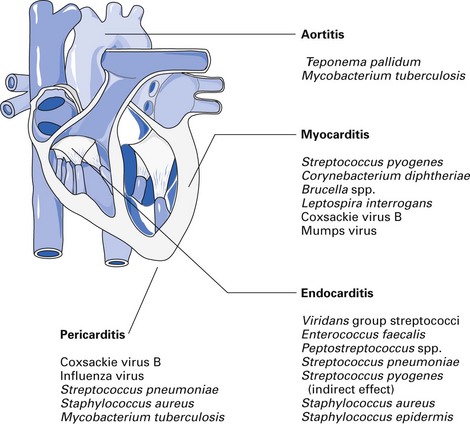Chapter 24 Infections of the cardiovascular system
Bacteraemia, septicaemia and sepsis syndrome
Definitions
Septicaemia and sepsis syndrome
Aetiology
Some common predisposing factors and agents that cause septicaemia are shown in Table 24.1.
Table 24.1 Some common predisposing factors and agents of septicaemia
| Predisposing factor | Agent |
|---|---|
| Abdominal sepsis | Enterobacteria |
| Bacteroides fragilis | |
| Enterococcus faecalis | |
| Infected wounds, burns | Staphylococcus aureus |
| Streptococcus pyogenes | |
| Enterobacteria | |
| Osteomyelitis | Staphylococcus aureus |
| Pneumonia | Streptococcus pneumoniae |
| Intravascular devices | Staphylococcus aureus |
| Staphylococcus epidermidis | |
| Enterobacteria | |
| Food poisoning | Salmonella spp. |
| Campylobacter spp. | |
| Meningitis | Streptococcus pneumoniae |
| Neisseria meningitidis | |
| Haemophilus influenzae | |
| Immunosuppressed patients | Enterobacteria |
| Staphylococcus aureus, etc. |
Pathogenesis and clinical features
Once the blood stream is invaded by microbes, the host responds by activating its defence mechanisms, leading to the production of a cascade of inflammatory cytokines (e.g. interleukin-1, tumour necrosis factor; see Chapter 10). The cytokine release is orchestrated by endotoxins of Gram-negative bacteria, peptidoglycan of Gram-positive bacteria and exotoxins from both these groups. Generally, these cytokines are beneficial in eliminating the organisms, but excessive production may lead to organ dysfunction and circulatory septic shock – the sepsis syndrome.
Infections of the heart
Important pathogens that cause pericarditis, myocarditis and endocarditis are shown in Figure 24.1. Of these, infective endocarditis is the most important disease of relevance to dentistry.
Infective endocarditis
Microbial aetiology
Bacteria are predominantly involved, although other organisms, such as fungi, rickettsiae and chlamydiae, may occasionally cause endocarditis (Table 24.2). More than 80% of infective endocarditis is caused by streptococci and staphylococci. The position held by the viridans group of organisms in the league table indicates the major role played by the oral commensals in causing this life-threatening disease. It is noteworthy that nearly all patients with viridans endocarditis have a previous heart lesion, and about a quarter give a history of a recent dental procedure as a precipitating factor.
Table 24.2 Causative microorganisms in infective endocarditis
| Microorganisms | Cases (%) |
|---|---|
| Total streptococci | 60 |
| Viridans group | 35 |
| Enterococcus faecalis | 13 |
| Microaerophilic streptococci | 3 |
| Anaerobic streptococci | 2 |
| Others | 7 |
| Total staphylococci | 25 |
| Staphylococcus aureus | 20 |
| Staphylococcus epidermidis | 5 |
| Miscellaneous | 5 |
| Culture-negative | 10 |
(cumulative data from several sources)
Diagnosis
Clinical signs supported by positive blood culture are used to make the diagnosis. Repeated culture may be necessary to isolate the causal organism owing to the low-grade bacteraemia. If possible, blood should be collected when the temperature of the patient rises, indicating fever due to bacteraemia. At least 10 ml of blood should be collected prior to antibiotic therapy and cultured under aerobic and anaerobic conditions (see Fig. 6.4). Any agent isolated from two different blood culture sets (on separate occasions) is considered significant. Identification and antibiotic sensitivity tests are then performed on the isolate.
Pathogenesis and epidemiology
Infective endocarditis normally occurs in patients with some pathological condition of the endocardium, although those with apparently normal heart valves may rarely be affected. The predisposing conditions include valve prostheses, septal defects, atheroma of the valve, congenital valve deformities and pre-existing rheumatic fever (Table 24.3). Infective endocarditis is the end result of the sequential interaction of events shown in
Stay updated, free dental videos. Join our Telegram channel

VIDEdental - Online dental courses



